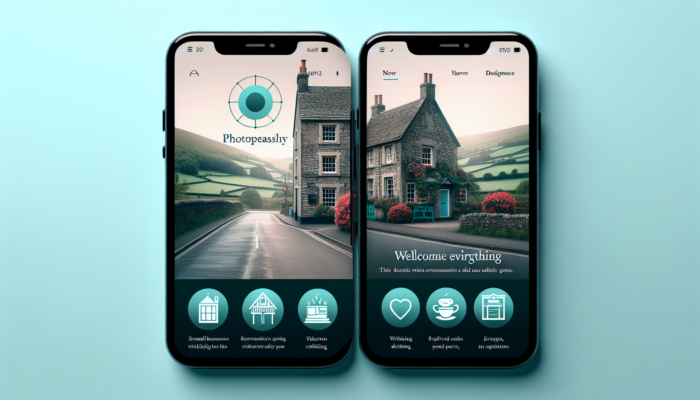Serving local customers for over 25 years.
Trusted by local business for reliable website design, SEO services and Digital Marketing in Somerset, Dorset, Devon, Wiltshire and Gloucestershire. 30 years of online marketing experience across the world.
Table of Contents
ToggleComprehensively Exploring the Essentials of Online Marketing
Online marketing has transformed how businesses engage with customers, facilitating unprecedented interaction and connection. At its core, a digital marketing strategy includes all marketing initiatives that harness online platforms, creating opportunities for enterprises and customers to flourish in an expansive digital marketplace. This multifaceted approach encompasses various channels such as websites, social media, email, and paid advertising, all intricately integrated into a cohesive strategy designed to achieve quantifiable results and enhance customer experiences.
The foundation of a successful digital marketing strategy lies in its essential components, which function synergistically to boost visibility and attract traffic. Key elements such as search engine optimisation (SEO), content marketing, social media engagement, and paid advertising are critical components that, when effectively harmonised, form a powerful marketing engine. Each element plays a distinct role, from enhancing organic search rankings to interacting with audiences in real-time across various social media platforms, ensuring a robust online presence.
The advantages of online marketing are diverse and plentiful. One of the most compelling aspects is the ability to generate measurable results, enabling businesses to accurately monitor performance and return on investment (ROI). In contrast to traditional marketing, which often relies on estimations, online marketing grants access to sophisticated data analytics that provide insights into consumer behaviour and the effectiveness of campaigns. Furthermore, it tends to be more cost-effective than conventional methods, allowing even small enterprises to compete globally. The rapid reach afforded by online marketing empowers organisations to engage with audiences worldwide, transcending geographical limitations and unlocking new pathways for growth.
Defining the Scope of Internet Marketing

Internet marketing encompasses a wide array of activities that leverage online platforms to connect with consumers. These efforts include developing engaging websites, actively participating on social media, and executing targeted email campaigns. Essentially, it represents the innovative fusion of technology and marketing principles, empowering brands to reach their audiences in unique and effective ways that resonate with modern consumer expectations.
In the current digital era, the definition of marketing has expanded significantly. The days of relying solely on print advertisements or personal interactions are long gone. Today's consumers are more connected than ever, spending considerable time online. Consequently, businesses must shift their strategies to focus on digital platforms where their target audiences congregate. This evolution demands a comprehensive understanding of the various online channels and how to utilise them effectively to maximise impact.
A well-designed digital marketing strategy capitalises on this connectivity by fostering meaningful consumer relationships through engaging, personalised content. By leveraging insightful analytics, businesses can better understand customer preferences and behaviours, enabling tailored marketing approaches that resonate more profoundly with their audiences.
Essential Components of a Comprehensive Marketing Strategy
An effective digital marketing strategy consists of several vital components, each playing a critical role in the overall success of a campaign. The primary elements include SEO, content marketing, social media engagement, and email marketing. When these components synergise seamlessly, they create a formidable engine for driving traffic, generating leads, and enhancing conversion rates.
Search engine optimisation (SEO) is fundamental to any digital marketing initiative. It involves optimising your website's content and structure to achieve higher rankings in search engine results, thereby increasing visibility and attracting organic traffic. SEO encompasses both on-page and off-page strategies, ensuring that your site is relevant to search queries and authoritative within its niche, which is vital for establishing credibility.
Content marketing is another essential pillar of a successful online marketing strategy. It involves creating valuable, relevant content designed to attract and retain a clearly defined audience. Various forms of content, including blogs, videos, infographics, and more, deliver value that encourages user engagement and sharing, ultimately fostering a loyal community around your brand.
Social media is pivotal in connecting audiences in real-time, facilitating engagement and interaction. Businesses can cultivate community and brand loyalty by selecting the appropriate platforms and tailoring content to fit each channel's unique characteristics. Finally, email marketing allows for direct customer communication, providing tailored messages that nurture leads and encourage conversions through well-crafted campaigns.
In essence, each of these components is interdependent, and the success of one often hinges on the effectiveness of the others. A well-rounded digital marketing strategy harnesses the strengths of each element to create a cohesive approach that drives tangible results.
Exploring the Multifaceted Benefits of Online Marketing
The myriad benefits of online marketing provide businesses with compelling reasons to adopt digital strategies. One of the most significant advantages is the capacity to achieve measurable results. Unlike traditional marketing channels, where gauging success can be challenging, online marketing offers extensive analytical tools that enable businesses to evaluate performance in real-time. This data-driven approach empowers organisations to make informed decisions, pivot strategies as needed, and allocate resources more effectively.
Utilising platforms like Google Analytics allows businesses to gain insights into website traffic, user behaviour, and conversion rates. This wealth of data facilitates a continuous optimisation, ensuring that marketing efforts are consistently refined for maximum impact. Measuring the effectiveness of campaigns has never been easier, allowing businesses to enhance their strategies continually and remain competitive in a dynamic market.
Cost-effectiveness is another compelling reason for organisations to pursue online marketing. Digital advertising typically necessitates a lower investment than traditional channels, such as print or television. This affordability opens doors for businesses of all sizes, from multinational corporations to local startups. Moreover, the ability to target specific demographics ensures that marketing budgets are utilised efficiently, reaching the right audiences at the optimal times.
Ultimately, the instantaneous reach afforded by online marketing enables businesses to connect with a global audience, breaking down geographical barriers. This capability means that even small enterprises can compete internationally, engaging potential customers across various countries and cultures. By harnessing the power of the internet, organisations can expand their market reach, drive growth, and increase brand awareness significantly.
Unlocking the Power of Search Engine Optimisation (SEO)

In the contemporary digital landscape, search engine optimisation (SEO) is the cornerstone of any effective digital marketing strategy. By enhancing a website's visibility on search engines, businesses can attract organic traffic and elevate their online presence. SEO involves various techniques that can be broadly categorised into three primary areas: on-page SEO, off-page SEO, and technical SEO.
Implementing Effective On-Page SEO Techniques
On-page SEO refers to optimising individual web pages to improve their ranking and relevance for specific keywords. This process encompasses numerous elements, including keyword research, content creation, and HTML optimisation. The initial step in crafting an effective on-page SEO strategy is conducting thorough keyword research to identify the terms and phrases your target audience employs when searching for products or services.
Once you have pinpointed relevant keywords, the next step is to incorporate them strategically throughout your content. This includes optimising title tags, meta descriptions, headings, and body content. However, maintaining a natural flow in your writing is crucial; keyword stuffing can lead to penalties from search engines. Instead, focus on crafting high-quality, engaging content that addresses the needs and interests of your audience while seamlessly integrating key phrases.
Another vital aspect of on-page SEO is ensuring that your website is user-friendly. This encompasses optimising page load speeds, ensuring mobile responsiveness, and establishing an intuitive navigation structure. Search engines prioritise websites that deliver a seamless user experience, rewarding them with higher rankings. Concentrating on content and technical aspects can significantly enhance your on-page SEO efforts and improve your overall search visibility.
Utilising Off-Page SEO Strategies for Enhanced Authority
While on-page SEO focuses on a website's internal elements, off-page SEO involves strategies that occur external to your site. This primarily revolves around increasing your website's authority through external signals, most notably through backlinks. Backlinks are links from other websites that point to your site, acting as endorsements that enhance your credibility in the eyes of search engines.
Building a robust backlink profile necessitates a strategic approach. One effective method is to create high-quality, shareable content that naturally attracts links from other websites. This could include in-depth articles, insightful research studies, or engaging infographics. Additionally, outreach efforts to industry influencers and bloggers can aid in securing guest post opportunities or collaborations that result in valuable backlinks.
Social media also plays a critical role in off-page SEO. Sharing your content across various platforms boosts visibility and drives traffic back to your site. Engaging with your audience on social media can lead to shares and mentions, further enhancing your online presence and authority.
A comprehensive off-page SEO strategy ultimately complements your on-page efforts, creating a holistic approach that improves search rankings, drives organic traffic, and builds brand reputation.
Mastering Technical SEO Essentials

Technical SEO is a crucial element of any effective digital marketing strategy. It ensures that your website is structured correctly and functions optimally for both users and search engines. Key components of technical SEO encompass website architecture, site speed, mobile-friendliness, and crawlability.
A well-organised website enables search engines to efficiently index your pages, helping them better understand your content and relevance. This entails structuring your site with a clear hierarchy, utilising internal linking effectively, and ensuring that URLs are descriptive and easy to read. A robust sitemap can also facilitate easier navigation for search engines, enabling them to find and index your content more efficiently.
Page speed is another critical factor in technical SEO. Research indicates that even a minor delay in page load time can significantly affect user experience and bounce rates. Optimising images, minifying code, and leveraging browser caching effectively enhance site speed and ensure user satisfaction.
In today's mobile-centric world, websites must be mobile-friendly. This entails ensuring your site is responsive, adapting seamlessly to various screen sizes and devices. Search engines prioritise mobile-friendly sites, so investing in responsive design is essential for maintaining a competitive edge in the digital arena.
Lastly, ensuring that your website is easily crawlable by search engines is paramount for effective SEO. Implementing structured data can assist search engines in comprehending your content better while enhancing rich snippets in search results, ultimately improving click-through rates. Focusing on these technical aspects can create a solid foundation for your SEO efforts and drive sustained organic traffic to your site.
Harnessing the Power of Content Marketing
Content marketing is at the heart of any robust digital marketing strategy, serving as a conduit for communication between businesses and their audiences. It involves creating valuable, relevant content designed to attract and engage a clearly defined audience. The ultimate aim is to drive profitable customer actions, whether purchasing a product, signing up for a newsletter, or sharing content with others, thereby fostering deeper connections with your brand.
Strategies for Creating Valuable Content
Valuable content is the cornerstone of effective content marketing. It attracts and retains a clearly defined audience, ultimately nurturing brand loyalty and driving conversions. To create content that resonates, it is essential to understand your audience's needs, preferences, and pain points. Conducting market research, surveys, and analysing customer feedback can provide valuable insights into your audience's values.
Once you clearly understand your audience, you can formulate a content strategy that directly addresses their specific needs. This could involve producing informative blog posts, engaging videos, or compelling infographics that provide actionable insights or entertainment. The key is to ensure that your content is informative and engaging, encouraging readers to share and interact with it, thus maximising its reach and impact.
Additionally, the format and delivery of your content play a significant role in its effectiveness. Experimenting with different content and distribution channels can help you identify what resonates best with your audience. For instance, while long-form blog posts may be effective for specific topics, short, punchy videos might resonate better with others, allowing you to cater to a diverse audience.
Ultimately, valuable content aims to forge a meaningful connection with your audience, positioning your brand as a trusted authority within your industry. By consistently delivering high-quality content, you can cultivate a loyal following and drive profitable actions contributing to your business objectives.
Exploring Effective Content Distribution Channels
Effective content distribution is essential for maximising the reach and impact of your content. While creating high-quality content is crucial, ensuring that it reaches your target audience through the right channels is equally important. Various platforms can be utilised for content distribution, each offering unique advantages that can enhance your marketing efforts.
Blogs serve as a foundational platform for content distribution. Regularly publishing relevant posts on your website establishes authority within your niche and attracts organic traffic through SEO. Moreover, blogs provide opportunities to engage with your audience through comments and discussions, fostering a sense of community around your brand.
Social media platforms offer another powerful avenue for content distribution. With billions of users worldwide, social media provides an unparalleled opportunity to reach diverse audiences. Tailoring your content to fit each platform—Facebook, Twitter, Instagram, or LinkedIn—can significantly enhance engagement. Furthermore, encouraging user-generated content can amplify your reach and fortify community ties.
Email marketing remains a highly effective channel for distributing content directly to your audience. By segmenting your email list and tailoring content to specific groups, you can ensure that your messages resonate with recipients, increasing the likelihood of engagement. Regular newsletters, promotional offers, and exclusive content can all be effectively delivered via email, nurturing leads and driving conversions.
Adopting a multi-channel approach to content distribution can significantly enhance your reach, driving traffic to your website and fostering stronger connections with your audience. By strategically selecting the appropriate channels, you can ensure that your content reaches those who will benefit most from it, thereby maximising its impact.
Measuring the Success of Your Content Marketing Efforts
Measuring the success of your content marketing initiatives is essential for understanding their effectiveness and refining your strategy over time. Various metrics, including page views, time on page, bounce rates, and conversion rates, can be employed to gauge the impact of your content.
Page views offer a basic indication of interest, showing how often your content has been viewed. However, this metric alone does not provide a comprehensive picture. Time on page can yield more profound insights, revealing how engaged your audience is with your content. A high average time on page suggests that visitors find your content valuable and are willing to invest time in reading it, indicating that your content resonates with your audience.
Bounce rates, the percentage of visitors who leave your site after viewing only one page, can indicate whether your content aligns with user expectations. A high bounce rate may suggest your content is irrelevant or engaging enough to encourage further exploration of your site, signalling a need for improvement.
Conversion rates are perhaps the most telling metric when measuring content success. This metric reveals the percentage of visitors who take a desired action, such as signing up for a newsletter or purchasing. By tracking conversions, you can assess the effectiveness of your content in driving profitable customer actions, allowing for data-driven decision-making that enhances future strategies.
Ultimately, leveraging these metrics enables you to make informed adjustments that enhance the performance of your content marketing strategy. By continuously monitoring and refining your approach, you can maximise the impact of your content and achieve your marketing goals with greater efficacy.
Embracing Content Personalisation for Enhanced Engagement
Personalisation has emerged as a successful form of content marketing in the modern digital landscape. Tailoring content to individual preferences and behaviours increases relevance and engagement, fostering stronger connections with your audience. By understanding your audience's needs and interests, you can create personalised experiences that resonate deeply, leading to meaningful interactions.
Customer data analytics plays a crucial role in content personalisation. By leveraging in-person interactions, social media engagement, and email responses, you can identify patterns and preferences within your audience. This information informs your content strategy, allowing you to create targeted messages that speak directly to individual needs and enhance overall user experience.
Personalisation can take many forms, from personalising a recipient's name in email marketing to recommending products based on past purchases. Dynamic content—where the displayed content changes based on user behaviour—can further elevate the user experience and increase engagement rates. For instance, a website may present different content to returning visitors compared to first-time users, creating a more tailored experience that resonates with each segment of your audience.
Moreover, personalisation is not limited to personal communication. Segmenting your audience into distinct groups based on demographics, interests, or behaviours can help you deliver more relevant content to each segment. This approach ensures that your marketing efforts resonate more profoundly, leading to higher conversion rates and enhanced customer satisfaction.
By embracing content personalisation, businesses can build lasting relationships with their audience. In an era where consumers expect tailored experiences, delivering personalised content is essential to stand out in a crowded marketplace and achieve sustainable growth.
Maximising Value Through Content
Repurposing existing content is a highly effective strategy for extending the lifespan of your material and reaching new audience segments. By transforming content into different formats, you can maximise its potential and ensure it resonates with diverse preferences and consumption styles, amplifying your overall reach.
For instance, a thoroughly researched blog post can be transformed into an engaging infographic, making the information more digestible and visually appealing. Similarly, a comprehensive video can be edited into shorter clips for social media, allowing you to share bite-sized highlights that attract attention and drive traffic back to the complete content, enhancing user engagement.
Repurposing also enables you to reach audiences that may prefer different platforms. While some users may enjoy reading articles, others like watching videos or listening to podcasts. By diversifying your content formats, you can cater to various preferences and significantly increase your overall reach, ensuring your messages resonate across different platforms.
Additionally, repurposing can save time and resources. Rather than continually creating new content from scratch, leveraging existing material allows you to maximise your efforts and enhance them. This is particularly beneficial for businesses with limited resources, as it enables them to maintain a consistent output of quality content without overwhelming their teams.
Incorporating content repurposing into your content marketing strategy can significantly enhance your visibility and engagement. By creatively transforming your existing material, you can ensure that it continues to deliver value long after its initial publication, extending its lifecycle and impact across your marketing channels.
Harnessing the Power of Social Media Marketing
Social media marketing has become an indispensable component of any digital marketing strategy. With billions of users across various platforms, social media offers businesses a unique opportunity to connect with their audiences in real time. Understanding how to leverage social media effectively can significantly enhance brand visibility, engagement, and customer loyalty, ultimately driving conversions and business growth.
Selecting the Most Effective Social Media Platforms
Choosing the right social media platforms is crucial for maximising your marketing efforts. Platforms cater to varied demographics and content types, making it essential to align your choices with your target audience's preferences. For instance, visually-driven content thrives on platforms like Instagram and TikTok, appealing primarily to younger audiences, while LinkedIn is more suited for professional networking and B2B marketing.
Identifying where your audience spends their time online is the first step in selecting the most effective platforms. Conducting market research and analysing competitor strategies can yield valuable insights into which platforms are most successful within your industry. Once you clearly understand your audience's preferences, you can tailor your content to suit each platform's specific characteristics and expectations, enhancing engagement and brand affinity.
Moreover, it is essential to consider your marketing goals when selecting platforms. Are you aiming to increase brand awareness, drive traffic, or foster community engagement? Each platform offers unique tools and features designed to support different objectives. For instance, Facebook excels in community building and sharing long-form content. At the same time, Twitter shines in real-time engagement and news dissemination, allowing for diverse strategies within your overall marketing approach.
By strategically selecting the most effective social media platforms, businesses can enhance their marketing efforts, maximise their reach, and ultimately strengthen connections with their audience, driving brand loyalty and engagement.
Engaging Your Audience Effectively
Engagement lies at the heart of successful social media marketing. Actively interacting with your audience fosters a sense of community and loyalty, encouraging users to advocate for your brand. Engaging with your audience involves responding to comments, initiating conversations, and sharing user-generated content, all of which create a more dynamic online presence and reinforce brand identity.
Responding promptly to comments and messages demonstrates that you value your audience's input and are committed to nurturing relationships. This can significantly enhance customer satisfaction and encourage users to return to your profiles regularly. Additionally, initiating discussions through polls, questions, or contests can stimulate engagement and encourage followers to share their opinions or experiences, further building a community around your brand.
User-generated content (UGC) is another powerful tool for engagement. By encouraging your audience to share content related to your brand, you can foster a sense of community and showcase authentic experiences. This enhances your brand's credibility and provides you with valuable content to share on your channels, further deepening audience engagement and brand loyalty.
Ultimately, engaging your audience on social media is about building meaningful relationships. By fostering a two-way dialogue, businesses can cultivate a loyal community that supports their brand and contributes to its long-term success.
Analysing Social Media Metrics for Continuous Improvement
Analysing relevant metrics that reflect performance is crucial to ensuring the practicality of your social media marketing efforts. Metrics such as reach, engagement, and follower growth provide valuable insights into how your content resonates with your audience and indicate the overall health of your social media presence.
Reach measures the number of unique users who have seen your content, offering insights into how effectively your messages are disseminated. Monitoring reach can help you identify which types of content are most appealing to your audience, enabling you to refine your strategy over time and maximise impact.
Engagement metrics, such as likes, shares, comments, and click-through rates, reveal how actively your audience interacts with your content. High engagement rates indicate that your content resonates with your audience, while low rates may suggest adjusting your approach to meet audience expectations better.
Follower growth is another key metric that indicates the success of your efforts to attract and retain an audience. A steady increase in followers can signify that your content is compelling and that users find value in your brand. Conversely, a decline in followers may warrant a reassessment of your content strategy or engagement tactics to ensure alignment with audience interests.
By regularly analysing these metrics, businesses can refine their social media strategies, ensuring they continually resonate with their audience and drive meaningful engagement that contributes to their marketing objectives.
Maximising Results with Email Marketing
Email marketing remains one of the most effective channels for reaching and engaging customers within a digital marketing strategy. Despite the rise of social media and other digital platforms, email delivers a significant return on investment, making it an essential tool for businesses of all sizes.
Strategies for Building a High-Quality Email List
Building a robust email list is the foundation of any successful email marketing campaign. A strong list allows you to reach your audience directly, delivering targeted messages that can drive engagement and conversions. Building an email list involves collecting email addresses from various sources, including website visitors, social media followers, and offline events.
One effective method for growing your email list is offering sign-up incentives. This could include exclusive content, discounts, or access to webinars. By providing value upfront, you increase the likelihood that users will share their email addresses and engage with your brand, fostering a sense of loyalty from the outset.
Additionally, incorporating sign-up forms on your website and social media channels is essential for collecting email addresses. Ensure these forms are easily accessible and straightforward, minimising entry barriers and sign-ups from interested users.
Furthermore, maintaining a clean email list is crucial for successful email marketing. Regularly removing inactive subscribers and ensuring compliance with data protection regulations, such as GDPR, helps maintain the integrity and effectiveness of your campaigns, ensuring that your communications reach engaged recipients.
By building a high-quality email list, businesses can enhance email marketing efforts and cultivate meaningful relationships with their audience, driving engagement and conversions over time.
Crafting Impactful Emails for Maximum Engagement
Crafting effective emails is essential for maximising the impact of your campaigns. Successful emails are personalised, feature compelling personalisation, and provide tangible value to the reader.
Personalisation is key to making your emails personal to recipients. This can involve addressing subscribers by name, segmenting your audience based on preferences, or tailoring content to specific interests. Personalised emails typically yield higher click-through rates, demonstrating that you understand and value your audience's needs and fostering deeper connections.
Compelling subject lines are crucial in encouraging recipients to open your emails. A well-crafted subject line should be concise, intriguing, and relevant to the content of the email. Experimenting with different styles and formats can help you determine what resonates best with your audience, enhancing overall engagement.
Providing value in your emails is paramount to fostering engagement and encouraging conversions. This could involve sharing informative content, special promotions, or exclusive offers. The key is to ensure that each email delivers something of worth, making it a valuable addition to your subscribers' inboxes and reinforcing their connection with your brand.
By focusing on personalisation, compelling, subject-personalised, value-driven content, businesses can enhance the effectiveness of their email marketing campaigns and drive meaningful engagement with their audience, ultimately leading to increased conversions and brand loyalty.
Evaluating the Success of Your Email Campaigns
Measuring the success of your email marketing campaigns is essential for understanding their effectiveness and optimising future efforts. Various optimisations, including open rates, click-through rates, and conversions, can be employed to assess campaign performance.
Open rates indicate the percentage of recipients who opened your email, representing how compelling your subject line was. High open rates suggest that your subject lines are engaging, while low rates may necessitate adjustments to your approach to ensure greater appeal.
Click-through rates (CTR) measure the percentage of recipients who clicked on links within your email, providing insights into how effectively your content prompted engagement. By analysing CTR, you can identify which content resonates best with your audience and refine your strategies to drive better results.
Conversions, which measure the percentage of recipients who take a desired action, such as purchasing or signing up for a webinar, are perhaps the most telling metric. By tracking conversions, you can assess the overall effectiveness of your email marketing campaigns in driving profitable customer actions, allowing for informed adjustments that optimise your approach.
Businesses can refine their strategies by leveraging and optimising metrics and continuously monitoring their email campaigns. This ensures they resonate with their audience and drive meaningful results that contribute to overall marketing objectives.
Enhancing Engagement through Email List Segmentation
Segmenting your email list is a powerful strategy for enhancing the effectiveness of your email marketing campaigns. By categorising subscribers based on demographics, interests, or behaviours, you can tailor your content to better resonate with each segment, ultimately driving higher engagement and conversions.
Segmentation allows for more personalised communication, which personalises engagement and builds relationships. For instance, you might segment your list based on past purchase behaviour, sending targeted offers to customers who have previously bought specific products. This tailored approach can significantly increase the likelihood of conversions, as recipients receive messages that align with their interests and previous interactions with your brand.
Additionally, segmentation enables you to deliver more relevant content to your audience. By understanding the preferences and interests of each segment, you can create targeted campaigns that address their specific needs. This level of personalisation enhances engagement and positions your brand as a trusted authority within your industry, fostering loyalty and repeat business.
Moreover, segmenting your email list can improve metrics across the board. Personalised emails tend to have higher open rates and conversions, resulting in a more effective email marketing strategy that drives significant results.
By embracing segmentation, businesses can significantly enhance the impact of their email campaigns, fostering deeper connections with their audience and driving meaningful results that contribute to overall marketing success.
Exploring Pay-Per-Click Advertising (PPC)
Pay-per-click (PPC) advertising is a powerful tool in any digital marketing strategy. By allowing businesses to bid on keywords and display ads in search engine results, PPC effectively drives targeted website traffic. Understanding how to set up and optimise PPC campaigns is crucial for maximising return on investment and achieving maximum outcomes.
Steps for Setting Up Successful PPC Campaigns
Setting up a successful PPC campaign involves several critical steps, including selecting the right keywords, crafting compelling ad copy, and establishing budgets. The first step is conducting thorough keyword research to identify the terms your target audience is searching for. This process involves using tools such as Google Keyword Planner to discover relevant keywords with high search volumes and low competition, ensuring your campaigns are positioned for success.
Once you have identified your target keywords, the next step is to create compelling ad copy that captures the attention of potential customers. Your ad should be clear, concise, and aligned with the search intent of the keywords you are targeting. Including a strong call-to-action (CTA) is essential for encouraging users to click on your ad and visit your website, thereby driving traffic and potential conversions.
Establishing a budget for your PPC campaign is equally important. This involves determining how much you are willing to spend per click and setting daily or monthly limits. It is crucial to monitor your spending closely, ensuring that you stay within budget while maximising the effectiveness of your campaign and achieving your marketing goals.
Lastly, continuously testing and refining your PPC campaigns is vital for achieving optimal results. A/B testing different ad variations can help you identify what resonates best with your audience, allowing you to adjust your strategies accordingly and enhance overall performance.
By focusing on keyword research, compelling ad copy, and smart budgeting, businesses can establish effective PPC campaigns that drive targeted traffic and maximise return on investment, ultimately maximising their overall marketing success.
Optimising Ad Performance for Exceptional Results
Optimising ad performance is crucial for ensuring that your PPC campaigns deliver the desired results. Regularly monitoring metrics such as click-through rates (CTR), conversion rates, and quality scores can provide insights into your ads' performance and where improvements can be made.
A high CTR indicates that your ad attracts attention and resonates with your target audience. If your CTR is low, it may signal that your ad copy needs enhancement or that you are targeting the wrong keywords. Testing different ad variations can help identify what captures your audience's interest and drives clicks, allowing for continuous campaign improvement.
Conversion rates measure the percentage of users who take a desired action after clicking on your ad. A low conversion rate may indicate that your landing page needs optimisation or that your ad's messaging does not align with user expectations. Ensuring that your landing page provides a seamless user experience and communicates the value of your offerings is essential for improving conversion rates.
Additionally, monitoring your quality score is crucial for optimising ad performance. A high-quality optimiser ensures that your ads are relevant and provide a good user experience, which can lead to lower costs per click and better ad placements. Regularly reviewing and refining your keywords, ad copy, and landing pages can help improve your quality score and overall campaign performance, driving better results.
By continually optimising ad performance, businesses can maximise the effectiveness of their PPC campaigns, driving targeted traffic and achieving meaningful results that contribute to their marketing objectives.
Frequently Asked Questions (FAQs)
What constitutes a digital marketing strategy?
A digital marketing strategy is a comprehensive plan that outlines how a business will utilise online platforms to promote its products or services, attract customers, and drive conversions effectively.
Why is SEO vital for digital marketing?
SEO is crucial for increasing a website's visibility in search engine results, helping attract organic traffic, and improving the chances of effectively reaching potential customers.
What advantages does content marketing offer my business?
Content marketing helps establish authority, engage audiences, and drive profitable customer actions by providing valuable, relevant content that resonates with your target audience. This ultimately leads to enhanced brand loyalty.
What role does social media play in digital marketing?
Social media allows businesses to connect with their audiences in real-time, engage with customers, and share content, ultimately enhancing brand visibility and loyalty and fostering community engagement.
How can I measure the effectiveness of my email marketing campaigns?
Success can be measured through key metrics such as open rates, click-through rates, and conversion rates, which provide insights into the effectiveness of your email campaigns and areas for improvement.
What is PPC advertising?
PPC advertising is a model in which advertisers pay a fee each time their ad is clicked. It allows businesses to display ads in search engine results, driving targeted traffic to their websites and increasing their visibility effectively.
What strategies can I implement to improve my website's loading speed?
Optimising images, minifying code, and levelling browser caching can improve loading speed. These techniques enhance user experience and contribute positively to SEO performance.
What does content repurposing involve?
Content repurposing involves transforming existing content into different formats, such as turning a blog post into an infographic or video, to extend its reach and lifespan across various platforms.
Why is email list segmentation essential?
Email list segmentation allows businesses to tailor content to specific groups, increasing relevance and engagement. This, ultimately, leads to higher conversion rates and enhanced customer satisfaction.
How often should I analyse my marketing metrics?
Analysing your marketing metrics regularly—ideally, managing them—allows you to identify trends, refine strategies, and ensure that your campaigns remain effective and aligned with your overall marketing goals.


















7 Comments
Your exploration of online marketing truly highlights the intricate dance between businesses and consumers in the digital landscape. It’s fascinating how the integration of various channels can create such a rich tapestry of interaction. I particularly resonate with the mention of search engine optimization (SEO) and content marketing as foundational elements. Having worked on several projects that emphasized these strategies, I’ve witnessed firsthand how they can elevate a brand’s visibility and foster genuine connections with an audience.
Your exploration of the essentials of online marketing truly highlights the intricate balance required for an effective digital strategy. I particularly appreciate how you emphasize the synergy among various components like SEO, content marketing, and social media engagement. This integrated approach is more than just a checklist of tactics; it reflects a holistic understanding of consumer behavior in our increasingly digital world.
It’s great to hear your thoughts on the interplay between businesses and consumers in the digital space. The way you describe that dynamic really captures the essence of what makes online marketing so engaging. I’ve found that the blend of SEO and content marketing acts almost like a two-way street, where not just brands push their messages, but audiences can interact, respond, and shape the conversation.
Your exploration of online marketing touches on a transformative aspect of our contemporary society—how businesses and consumers interact with one another in a digital landscape that grows more intricate by the day. The point you raise about the integral components of a digital marketing strategy harmonizing to create a powerful force is particularly compelling. It reminds me of the rich tapestry of human relationships; just as trust and understanding are vital for meaningful connections in life, so too are the elements of SEO, content, and social media crucial for fostering meaningful engagement in the digital realm.
You’ve picked up on something crucial about the digital landscape’s complexity. It’s worth noting that while SEO and content marketing are often celebrated, they can also lead to a kind of tunnel vision. Sometimes, brands become so focused on optimizing for algorithms that they forget the human element—storytelling that resonates on a personal level.
You’ve brought up a vital point about the digital landscape that resonates deeply with me. It’s easy to get caught up in the data and metrics when it comes to SEO and content marketing. I’ve seen it happen where brands chase rankings and conversions while losing sight of who they’re actually speaking to.
“Absolutely, balancing strategy with genuine storytelling is key! If you’re interested in exploring more about weaving authentic narratives into your digital approach, check out this insightful resource.”
https://ezi.gold/brownbook
I really appreciate how you’ve broken down the essential components of a digital marketing strategy. It’s fascinating to see how each element, like SEO and social media engagement, plays such a vital role in shaping customer experiences. In my own work, I’ve noticed that integrating these channels can lead to much richer interactions and better understanding of audience needs.